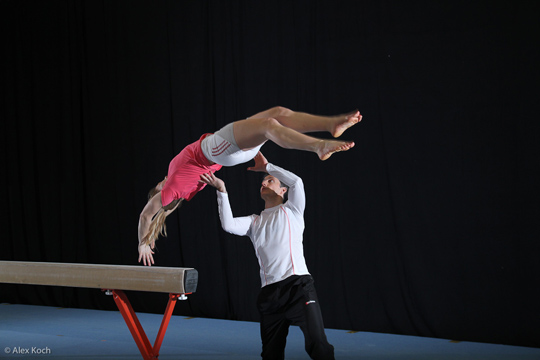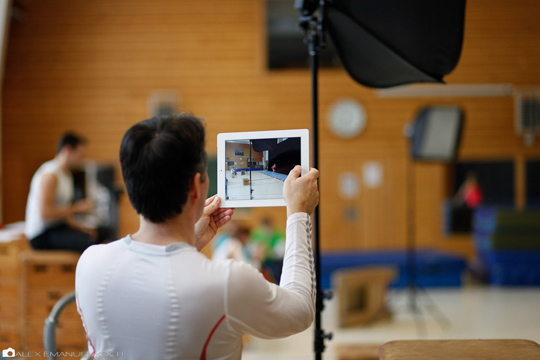The various phases of a handspring
Freiburg, Dec 03, 2020
The platform that was ahead of its time: A sports science project proves in the pandemic that teaching in this field can also be meaningfully supplemented by digital offerings. Using the example of a core sport - gymnastics, teachers and students are testing theoretical content in order to combine it more closely with practical exercises. They are also developing digital learning content for other students and physical education teachers.
 Flavio Bessi assists students with the ranges of motion you need for a rollover, somersault and handspring – now in digital form. Photo: Alex Koch
Flavio Bessi assists students with the ranges of motion you need for a rollover, somersault and handspring – now in digital form. Photo: Alex Koch
“In a double lesson you can easily learn to do a somersault or back a handspring,” says Dr. Flavio Bessi with conviction. The only question is how. Bessi teaches competitive gymnastics at the Department of Sport and Sport Science at the University of Freiburg. He has a lot of teaching experience from his time as a national and state coach. He knows that in competitive gymnastics nothing works without basics and that physical education students usually bring that along with them: “A handspring does not start with a handspring, but by first creating the prerequisites for performance. It requires strength, coordination and orientation skills,” says Bessi. And yet, such complexity initially deters gymnasts. However, when they start to divide the sequence of events of a handspring into phases, they realize that the individual steps are well feasible - and thus the feeling of being able to do it grows.
Bessi considers himself a visual person. During his teaching career, he has collected a lot of visual material, both for teaching and for scientific publications. Sports are virtually predestined to work with visualizations, says Bessi. This experience is included in an application both he and Prof. Dr. Albert Gollhofer placed entitled “DoppelfOERderung. Learning through teaching on and with devices.” Last fall, the University of Freiburg awarded the project, which also conveys learning content digitally, with its teaching development prize, the Instructional Development Award (IDA), worth 70,000 euros.
 Film recordings on the learning platform, which is also available on smartphone and tablet, show the exercises in real time. Photo: Alex Koch
Film recordings on the learning platform, which is also available on smartphone and tablet, show the exercises in real time. Photo: Alex Koch
Information on smartphones and tablets
A mind map of the project he drew hangs in Bessi’s office. In addition to the built-in videos on the learning platform, students will find graphics, web-based exercise programs and worksheets as well as quizzes, which are intended to provide a playful approach to the material. Bessi discovered that a reward system for the first or best entry was not as well received by the students as he had expected. However, their project was clearly ahead of the curve as corona came shortly thereafter, he says. The project is part of a wide-ranging digitization offensive in teaching, which, Bessi concludes, is often not quite as offensive as hoped. The aim is to create new teaching material for equipment-based gymnastics that runs on cell phones, tablets and computers and is partly generated by the students themselves. Bessi is certain that there is still room for improvement here. “Although we are teaching digital natives, digital readiness in society is not quite up to par yet,” says Bessi.
The project’s name “DoppelfOERderung. Learning by teaching on and with devices” is not only ambiguous with regard to the exercise devices, it also describes the interaction between learning and teaching. The title also alludes to the Baden-Württemberg network for the digitization of teaching OER (Open Eductional Resources), which was initiated by the University of Tübingen and is available for teachers and students in the state. All of them can use these resources, adapt them to their individual needs, and use them later in class. In this way, the knowledge acquired could seep into the schools through trainees and teachers, explains Bessi, so that the students could also benefit from it.
Advantage for schools during the pandemic
In recent weeks, Niklas Scherer has directly experienced how useful this platform and digital teaching material in general is. Scherer studies sports and English and is a participant in the course. He is currently doing an internship semester at the Städtisches Gymnasium Ettenheim. To make the sports lessons as contactless as possible is uncharted territory for everyone and means a considerable additional effort for all teachers, he says. Especially if there are students or teachers at the school who have tested positive for the SARS-CoV-2 virus, because then digital learning material has to be prepared in addition to presentation lessons. “The question of how we can manage to carry out teaching in other media is currently a hot topic,” he says. Scherer therefore believes that a platform like Bessi’s makes sense for other subjects as well.
During the seminar at the Department of Sport and Sports Science, he examined teaching at the upper secondary school and the curriculum and, together with a fellow student, wrote a paper on the subject of “Performance and Evaluation.” Although their approach was rather theoretical, they used the data provided by Bessi on the platform. The way they used it was up to them. Others, adds Bessi, have designed a website for a blog. “He who teaches, learns more,” he is convinced, as the model of educator Jean-Paul Martin shows. Other events included in the project were the in-depth and advanced course in equipment-based gymnastics in the bachelor’s program. Bessi emphasizes that the fundamental goal is to dovetail knowledge of sports, sports science and media education.
Motion sequences in real time
While the pandemic is proving just how relevant digital teaching is in practice, the project’s timetable got mixed up precisely for this reason. Since the theoretical teaching content was brought forward at the Department in spring, the hall was occupied by students when teaching was temporarily resumed in June, which is why no recordings could be made for the platform. As soon as Bessi talks about the possibilities of film techniques, he sounds enthusiastic: “Today we can see in real time how a person moves,” he says. The tracking system Vicon, which Gollhofer and his team use for many investigations in their area of the Department of Sport and Sports Science, can detect and record movements at a 360-degree angle. Teachers and students can thus discuss and reflect on the course of movement and see how the muscles work and what forces are acting on the body. This helps to know what is important in a somersault or a back handspring - and even brings the possibility of a double salto that much closer.
Annette Hoffmann

